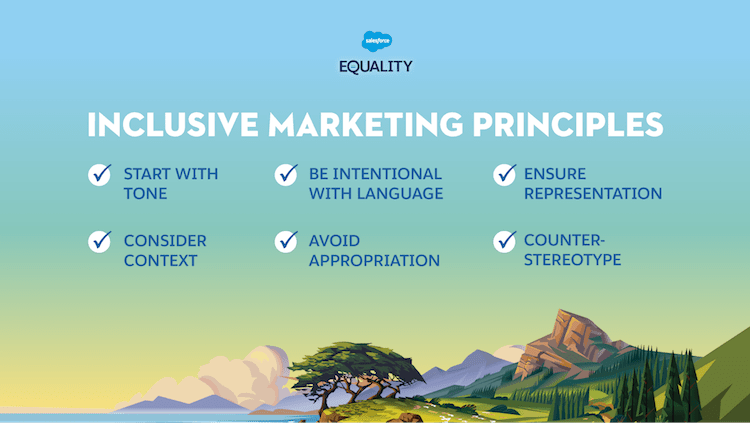The 6 Essential Principles of Inclusive Marketing Every Marketer Should Know



Salesforce published their Inclusive Marketing Principles learning module on Trailhead to help empower marketers to lead with their values, deepen connections with their customers, and reflects the diverse communities they serve. Learn how to put these principles into action and adopt an inclusive review process at your company. Read more . . .

Alexandra Siegel
Today we are proud to announce our new Equality Trailhead module, Inclusive Marketing Principles.
At Salesforce, we are committed to driving Equality in our workplaces and communities and leading with our values in everything we do. In that spirit, we set out to empower those on the front lines of our brand — our marketers — with the tools they need to reflect and elevate the diverse communities we serve. We spent months researching; collaborating with designers, content creators, and events leads; and convening focus groups to codify what has now become our 6 Principles of Inclusive Marketing. Today, we are publishing these principles on Trailhead, our free online self-learning platform, to share our practices with our greater community. We recognize that we don’t have all the answers and are committed to learning and evolving together.
Here’s a quick overview of the new learning module:
What is Inclusive Marketing?
We define inclusive marketing as creating content that truly reflects the diverse communities that our companies serve. It means that we are elevating diverse voices and role models, decreasing cultural bias, and leading positive social change through thoughtful and respectful content.
We believe that our responsibility as marketers is to relay our brands’ messaging in a way that resonates with people from all backgrounds, regardless of race, ethnicity, gender identity, age, religion, ability, sexual orientation, or otherwise.
Beyond diversity, truly inclusive marketing can elevate the stories and voices of people that have been typically marginalized or underrepresented, deepen connections with customers, and even influence positive social change.

Why is Inclusive Marketing so important?
As our societies become more diverse and interconnected, it’s more important than ever that companies are thoughtful about the messages, images, voices, and values that represent their brands — as well as their greater social impact. According to Salesforce’s new research, 90% of consumers believe that businesses have a responsibility to look beyond profit and improve the state of the world. Synchronously, Nielsen reports that “with 43% of the 75 million Millennials in the U.S. identifying as African American, Hispanic, or Asian, if a brand doesn’t have a multicultural strategy, it doesn’t have a growth strategy.”
An Overview of the 6 Inclusive Marketing Principles:
We’ve distilled our journey to creating inclusive marketing content into 6 key principles. As we discuss them, we remember to keep in mind “intention vs. impact”. This is the idea that most of the time we all have positive intent, but it’s the impact of our actions and content that we — and our businesses — are held accountable for.
In this module, we will deep dive into what each of these mean, real-life examples of the principles in action, and ways that company leaders and marketers can lead to ensure inclusive marketing at every step. Below are short summaries of each principle, learn more in our module.

1. Start with tone
Tone is the style, characteristic, or sentiment of a piece of content. Often when people are offended or turned off by a piece but can’t quite put their finger on why, tone is at the center. We suggest considering the intended subject, topic, message, and overall impact of a piece in the planning stages to help reach the right and respectful tone.
2. Be intentional with language
Language includes the words, phrases, symbols, or metaphors used to describe something. There is immense power in language — it can deepen understanding and strengthen relationships, or it can confuse or even cause harm. For these reasons, it’s an important practice to carefully consider every word, symbol, or phrase — not just what the words say, but also how and where they are placed.
3. Ensure representation
Representation is the visible presence of a variety of identities in a story, image, video, and more. There is immense power in representation. People want to see themselves reflected in media — it helps us to all feel empowered, inspired and heard. Before publishing an advertisement or hosting a panel, for example, ask — does this reflect society? Am I elevating diverse voices? We know that there is luminary, diverse talent all around us. It is up to us to make sure we are connecting them to our platforms and giving opportunities to all.
4. Consider context
Context can be defined as the circumstances that inform an event or piece of content. This could mean the historical or cultural influences and also extends to the order and hierarchy of the subjects. Many of us can think of ads in the past few years that incited controversy for seemingly missing important cultural context, often related to gender or racial equality.
Though, extremely nuanced, one example of order and hierarchy that many of us as marketers are familiar with appears in stock photography. When you search “manager and employee” often see a male employee standing over a woman colleague, implying certain power dynamics. At Salesforce, our content teams raised this issue to us and we worked to develop our own photography and revise our stock repository to ensure that our photos are not only diverse but that they are considering order and hierarchy while showing our subjects in the best light.

5. Avoid appropriation
Appropriation is often defined as taking or using an aspect from a minority culture without knowing or honoring the meaning behind it. Drawing from people’s cultures, traditions, and personal experiences can be both subjective and sensitive. We can all lead with cultural respect and awareness by being mindful of nuance and historical context, honoring and learning the culture, seeking guidance and diverse opinions, evaluating intent and impact, and elevating authentic voices.
6. Counter-stereotype
Counter-stereotype is a phrase that means going against a standardized image that represents an oversimplified opinion, prejudiced attitude, or uncritical judgment. Many of us have seen ads that play into harmful stereotypes, but imagine a world where the marketing images around us shattered these stereotypes rather than emboldened them. This is where we as marketers have the power to change the society around us.
We could start reimagining . . .
…what a CEO looks like:

….what an athlete looks like:

….what love looks like:

Adopt an inclusive review process
And finally, we want to help empower marketing teams across the globe with an inclusive review process to help catch any concerns or improve marketing before it goes out the door. Our steps include: putting on our equality glasses by looking at everything through the lens of the principle, having a diverse review panel, seeking input when in doubt, creating space for inclusive and anonymous feedback and prioritizing accessibility.
As we know that to truly lead with Equality in everything that we do means adopting inclusive practices across the business and that they are all interconnected. It’s important that we strive to create workplaces that reflect society in order to have diverse content creators and review panels. It is equally important to incorporate to create workplaces where everyone feels safe, valued, heard, and empowered to succeed as well as speak up. Learn more about how Salesforce approaches this in our Inclusive Leadership Principles.
Blaze your trail today
We all have the power to lead with inclusive marketing to deepen connections with our customers, elevate the diverse voices and stories all around us, and positively influence society. We recognize this is only the beginning but that these steps can help us make progress on a greater path. Let’s start together, today. Take the trail: sfdc.co/inclusivemarketing.
Learn more about our path toward equality for all at Salesforce.com/Equality.























